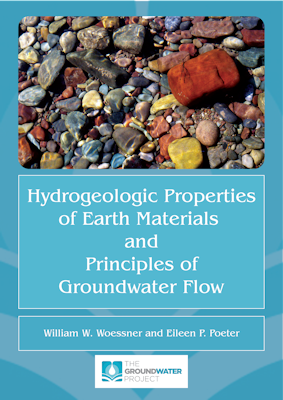Hydrogeologic Properties of Earth Materials and Principles of Groundwater Flow

Publication year: 2020
Number of pages: 205
ISBN: 978-1-7770541-2-0
Authors:
William W. Woessner – University of Montana, USA
Eileen P. Poeter – Colorado School of Mines, USA
Updated: 29 December 2020
Supplemental file:
Unconfined Flow with Recharge
Book Description
This book emphasizes the need for groundwater scientists to have a solid understanding of the occurrence and behavior of groundwater in a variety of conditions and settings. Knowledge of how porous media store, yield, and transmit water, and the factors that control groundwater flow rates and directions are highlighted. Eight Boxes present more detailed discussion of concepts introduced in the main text. Sixteen exercises and their solutions are also provided.
Groundwater is water found below the water table in the zone of saturation within the pores and cracks of a wide variety of earth materials. Groundwater occurrence in porous material is described in terms of total porosity, effective porosity, void ratio, volumetric moisture content, specific yield, and specific retention. Interconnected pore space provides for storage and transmission of groundwater.
The movement of groundwater is described by Darcy’s Law which states that the discharge of groundwater is directly proportional to the saturated area perpendicular to the direction of flow, the hydraulic gradient and the transmission capacity (hydraulic conductivity) of the earth material. Groundwater flow rates and directions are controlled by: forces on water within pore spaces and fractures; hydraulic heads; and the hydraulic conductivity of earth materials.
Unconfined, perched, and confined aquifers are groundwater systems that provide groundwater for water supplies. Properties of aquifers are described by transmissivity and storativity. In addition to zones that freely transmit groundwater, some materials inhibit flow and are described as confining units, leaky beds, and aquitards.
Groundwater flow conditions can be described using general equations called governing equations. These partial differential equations are derived and the conditions they describe are presented. Flow in earth materials where the transmission properties vary at every point and location are described by equations representing anisotropic and heterogeneous conditions. When constant values of hydraulic conductivity are representative of earth materials, anisotropic homogeneous or isotropic homogeneous equations are used.
The groundwater flow equations are applied to simple groundwater settings using prescribed boundary conditions. The application of the governing equations in more complex numerical models is also discussed.
The principles used to measure groundwater head in the field, assign physical and hydraulic boundary conditions, and determine groundwater flow directions in uniform and heterogeneous hydrogeologic settings are presented.
Case studies examine flow in: a regional groundwater system, a confined aquifer used for municipal water supply, and a local system associated with groundwater contamination from a smelter.

